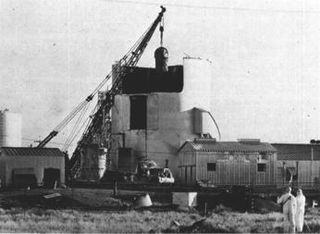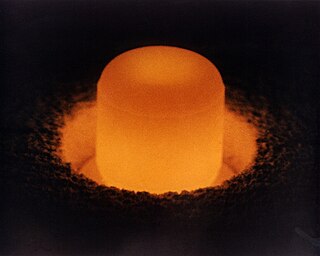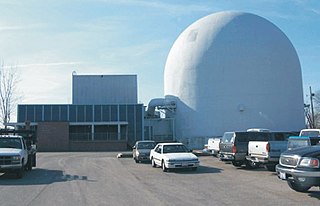
Brookhaven National Laboratory (BNL) is a United States Department of Energy national laboratory located in Upton, Long Island, and was formally established in 1947 at the site of Camp Upton, a former U.S. Army base and Japanese internment camp. Its name stems from its location within the Town of Brookhaven, approximately 60 miles east of New York City. It is managed by Stony Brook University and Battelle Memorial Institute.

NS Savannah was the first nuclear-powered merchant ship. She was built in the late 1950s at a cost of $46.9 million and launched on July 21, 1959. She was funded by United States government agencies. Savannah was a demonstration project for the potential use of nuclear energy. The ship was named after SS Savannah, the first steamship to cross the Atlantic ocean. She was in service between 1962 and 1972 as one of only four nuclear-powered cargo ships ever built.

The RBMK is a class of graphite-moderated nuclear power reactor designed and built by the Soviet Union. The name refers to its design where, instead of a large steel pressure vessel surrounding the entire core, the core is surrounded by a cylindrical annular steel tank inside a concrete vault and each fuel assembly is enclosed in an individual 8 cm (inner) diameter pipe. The channels also contain the coolant, and are surrounded by graphite.

Stationary Low-Power Reactor Number One, also known as SL-1 or the Argonne Low Power Reactor (ALPR), was a United States Army experimental nuclear reactor in the western United States at the National Reactor Testing Station (NRTS), later the Idaho National Laboratory, west of Idaho Falls, Idaho. It experienced a steam explosion on the night of January 3, 1961, killing all three of its young military operators, and pinning one of them to the ceiling of the facility with a reactor vessel plug. The event is the only reactor accident in U.S. history that resulted in immediate fatalities.

Health physics, also referred to as the science of radiation protection, is the profession devoted to protecting people and their environment from potential radiation hazards, while making it possible to enjoy the beneficial uses of radiation. Health physicists normally require a four-year bachelor’s degree and qualifying experience that demonstrates a professional knowledge of the theory and application of radiation protection principles and closely related sciences. Health physicists principally work at facilities where radionuclides or other sources of ionizing radiation are used or produced; these include research, industry, education, medical facilities, nuclear power, military, environmental protection, enforcement of government regulations, and decontamination and decommissioning—the combination of education and experience for health physicists depends on the specific field in which the health physicist is engaged.

The Savannah River Site (SRS) is a U.S. Department of Energy (DOE) reservation in the United States in the state of South Carolina, located on land in Aiken, Allendale, and Barnwell counties adjacent to the Savannah River, 25 miles (40 km) southeast of Augusta, Georgia. The site was built during the 1950s to refine nuclear materials for deployment in nuclear weapons. It covers 310 square miles (800 km2) and employs more than 10,000 people.
The ionization chamber is the simplest type of gas-filled radiation detector, and is widely used for the detection and measurement of certain types of ionizing radiation, including X-rays, gamma rays, and beta particles. Conventionally, the term "ionization chamber" refers exclusively to those detectors which collect all the charges created by direct ionization within the gas through the application of an electric field. It only uses the discrete charges created by each interaction between the incident radiation and the gas. Gaseous ionization detectors include ionization chambers and devices that use gas multiplication, namely the proportional counter and the Geiger counter.

Spent fuel pools (SFP) are storage pools for spent fuel from nuclear reactors. They are typically 40 or more feet (12 m) deep, with the bottom 14 feet equipped with storage racks designed to hold fuel assemblies removed from reactors. A reactor's local pool is specially designed for the reactor in which the fuel was used and is situated at the reactor site. Such pools are used for short-term cooling of the fuel rods. This allows short-lived isotopes to decay and thus reduces the ionizing radiation and decay heat emanating from the rods. The water cools the fuel and provides radiological protection from its radiation.

The High Flux Isotope Reactor (HFIR) is a nuclear research reactor at Oak Ridge National Laboratory (ORNL) in Oak Ridge, Tennessee, United States. Operating at 85 MW, HFIR is one of the highest flux reactor-based sources of neutrons for condensed matter physics research in the United States, and it has one of the highest steady-state neutron fluxes of any research reactor in the world. The thermal and cold neutrons produced by HFIR are used to study physics, chemistry, materials science, engineering, and biology. The intense neutron flux, constant power density, and constant-length fuel cycles are used by more than 500 researchers each year for neutron scattering research into the fundamental properties of condensed matter. HFIR has about 600 users each year for both scattering and in-core research.

Plutonium-238 is a fissile, radioactive isotope of plutonium that has a half-life of 87.7 years.

The Piqua Nuclear Power Facility was an organic cooled and moderated nuclear reactor which operated just outside the southern city limits of Piqua, Ohio in the United States. The plant contained a 45.5-megawatt (thermal) organically cooled and moderated nuclear reactor. The Piqua facility was built and operated between 1963 and 1966 as a demonstration project by the Atomic Energy Commission. The facility ceased operation in 1966. It was dismantled between 1967 and 1969, and the radioactive coolant and most other radioactive materials were removed. The remaining radioactive structural components of the reactor were entombed in the reactor vessel under sand and concrete.

The Advanced Test Reactor (ATR) is a research reactor at the Idaho National Laboratory, located east of Arco, Idaho. This reactor was designed and is used to test nuclear fuels and materials to be used in power plants, naval propulsion, research and advanced reactors. It can operate at a maximum thermal power of 250 MW and has a "Four Leaf Clover" core design that allows for a variety of testing locations. The unique design allows for different neutron flux conditions in various locations. Six of the test locations allow an experiment to be isolated from the primary cooling system, providing its own environment for temperature, pressure, flow and chemistry, replicating the physical environment while accelerating the nuclear conditions.
The Salt Waste Processing Facility (SWPF) is a nuclear waste treatment facility for the United States Department of Energy's Nuclear Reservation Savannah River Site in Aiken, South Carolina. It was designed, constructed and commissioned by the Parsons Corporation for treatment of nuclear salt waste and became operational in 2021.
Radiation damage is the effect of ionizing radiation on physical objects including non-living structural materials. It can be either detrimental or beneficial for materials.

Gadolinium(III) nitrate is an inorganic compound of gadolinium. This salt is used as a water-soluble neutron poison in nuclear reactors. Gadolinium nitrate, like all nitrate salts, is an oxidizing agent.
The RaLa Experiment, or RaLa, was a series of tests during and after the Manhattan Project designed to study the behavior of converging shock waves to achieve the spherical implosion necessary for compression of the plutonium pit of the nuclear weapon. The experiment used significant amounts of a short-lived radioisotope lanthanum-140, a potent source of gamma radiation; the RaLa is a contraction of Radioactive Lanthanum. The method was proposed by Robert Serber and developed by a team led by the Italian experimental physicist Bruno Rossi.
The Fukushima disaster cleanup is an ongoing attempt to limit radioactive contamination from the three nuclear reactors involved in the Fukushima Daiichi nuclear disaster that followed the earthquake and tsunami on 11 March 2011. The affected reactors were adjacent to one another and accident management was made much more difficult because of the number of simultaneous hazards concentrated in a small area. Failure of emergency power following the tsunami resulted in loss of coolant from each reactor, hydrogen explosions damaging the reactor buildings, and water draining from open-air spent fuel pools. Plant workers were put in the position of trying to cope simultaneously with core meltdowns at three reactors and exposed fuel pools at three units.

The Materials Testing Reactor (MTR) was an early nuclear reactor specifically designed to facilitate the conception and design of future reactors. It produced much of the foundational irradiation data that underlies the nuclear power industry. It operated in Idaho at the National Reactor Testing Station from 1952 to 1970.
Bluegrass Companies is a non-explosive demolition company headquartered in Greenville, Alabama. It was founded in 1979 by CEO and owner Nicholas Jenkins. The business comprises the sub-companies: Demolition Technologies, The Machine Shop, Bluegrass Concrete Cutting Inc., and Bluegrassbit. Bluegrass Company has always been headquartered in Greenville, Alabama, though now incorporated in Wyoming. The company is known for the advancement of diamond wire sawing as a technique for non-explosive demolition, later for the creation and patenting of an underwater diamond wire saw, and for assisting the U.S. Department of Energy with various tests as well as nuclear decommissioning.
The TR-2 nuclear reactor, also known as the Westinghouse Test Reactor or Westinghouse Testing Reactor (WTR) was a small research and test reactor designed and manufactured by Westinghouse Electric Corporation at their Waltz Mill site near Madison, Pennsylvania, approximately 30 miles southeast of Pittsburgh. TR-2 was the first privately owned research and test reactor. The reactor suffered an accident which involved severe fuel damage in 1960.













